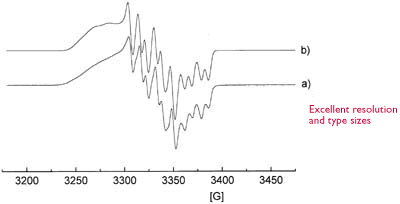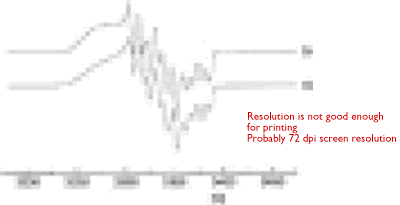|
|
|
All illustrations should be labelled as figures (and/or schemes) and numbered using Arabic numerals. Every figure must be cited in the text. There cannot be illustrations labelled as 'figures' and illustrations labelled as 'schemes' in the same article. A set of original documents or photographs should be provided for reproduction of the figures.
Whenever possible, figures should be submitted in their desired final size, i.e. 80 mm wide. Double column figures if they cannot be avoided should not exceed 175 mm in width.
No original document should in any case exceed A4 size (21 X 29.7 cm). Photographs and half-tones should contain good contrasts. See section belowe concerning the documents supplied in electronic format. There is no special charge for inclusion of colour plates in 2001.
In reaction diagrams it is preferable to indicate the main reagents and the experimental conditions above the arrow in preference to in a note under the equation.
Figures and structural formulae which are not on a single line will not be redrawn; they can be inserted in the text but should be provided on separate sheets at the end of the manuscript. They should be of high enough quality to allow direct reproduction. The figures should be on white paper and units and symbols should be consistent between the figures and with the text. Characters should be large enough to remain legible after a possible reduction of 70 %. The typeface Helvetica should preferably be used for text in the figures. If possible, it is recommended that ChemDraw™ is used (see tables I and II below for the settings); this style is used by the journals Synthesis and Synlett.
Please follow the requirements below to ensure that your electronic graphic file will be compatible with Word or WordPerfect and produce the best possible results by ensuring accuracy, clarity and a high level of detail.
- The graphic files must be saved as TIFF, EPS or JPEG.
- All type within the figures should be at least size 9.
- Use only following fonts: Helvetica, Arial, Times, Courrier, Symbol
- Line art should have a resolution of approximately 1 000 dpi.
- Half-tone graphics (photographs or graphics with shades of gray) should have a resolution of 300 dpi.
- A figure that is a combination of both a half-tone and line art must have a resolution of at least 500 dpi.
- Color: Please contact the editor prior to sub
- mission about the use of color figures when they are indispensable to the presentation.
|
Correct resolution of 800 dpi or more and consistent font size.

Low resolution results in bad quality output

Unequal type size of the text makes it very difficult to reduce the figures to be readable

|
|

